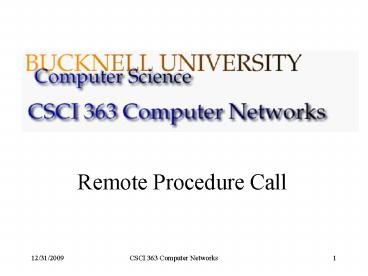Remote Procedure Call PowerPoint PPT Presentation
1 / 9
Title: Remote Procedure Call
1
- Remote Procedure Call
2
RPC Concepts
- Remote Procedure Call is a mechanism for
structuring distributed systems. It is based on
the semantics of a local procedure call - The application program makes a call intro a
procedure without regard for whether it is
executed locally or remotely and blocks until the
call returns.
Remember that the network between caller and
callee (client and server) may not be reliable
(duplicated or lost messages) and that there may
be significant architectural differences between
the two hosts (different data representation).
3
RPC Mechanism
- The major components in RPC are
- A protocol between caller and callee that makes
up for the undesirable properties of the network. - Programming language and compiler support the
arguments of a call must be put into a request
message and then translated to the callees
conventions. The returned data goes through a
similar process.
4
RPC Protocol Design
- The RPC protocol must provide several different
functions, mainly - Fragmenting and reassembling large messages,
- Synchronizing request and reply messages, and
- Dispatching request messages to the correct
process.
5
A Simple RPC Protocol Stack
- RPC is a generic term, not a specific standard
like UDP, or TCP. This gives us the opportunity
to design our own RPC protocol from scratch. - Our design will be based on three microprotocols
- BLAST fragmentation and reassembly,
- CHAN synchronization of reply and request
messages, and - SELECT dispatching of request messages to the
correct process.
6
BLAST
- The design principle behind BLAST is to send all
fragments to the receiver without waiting for
each one to be acknowledged individually. The
receiver uses a selective retransmission request
(SRR) as partial acknowledgements.
Format for BLAST message header
Spend a few minutes discussing with your group
how we can make BLAST work. Also, think of what
you would need to store in its message header.
7
CHAN
- Microprotocol CHAN implements synchronization in
the request/reply algorithm. It must also
guarantee reliable message delivery (no loss, no
duplication). - The protocol preserves the semantics
at-most-once for every request message, either
zero or one copy is delivered to the server. - When replies come almost immediately after
request, implicit acknowledgements can be used.
8
CHAN
Format for CHAN message header
- Spend a few minutes brainstorming with your
group. Try to provide answers to the following
questions - What message types CHAN needs?
- How can CHAN distinguish a dead server from a
slow server? - If you use message identifiers, how would CHAN
deal with hosts that reboot and reset the
identifier to the same old starting value? - How would CHAN implement synchronization?
9
SELECT
- Microprotocol SELECT must dispatch request
messages to the appropriate procedure in the
server host. - Brainstorm with your group and attempt to
identify the issues that drive an implementation
of SELECT. Two important points to consider are - The addressing scheme used to identify each
procedure. - SELECT is a good place to manage concurrency if
client (or caller) is multi-threaded, since CHAN
allows only one outstanding call at a time,
SELECT should allow for calls made from
independent threads to execute concurrently
rather than sequentially.

